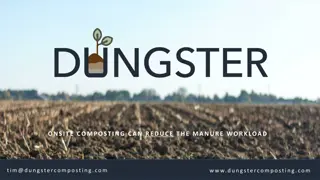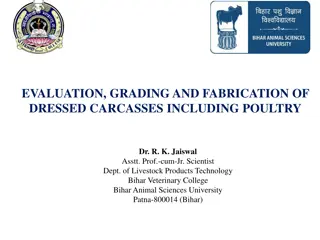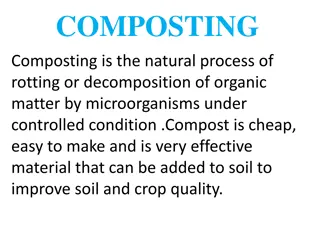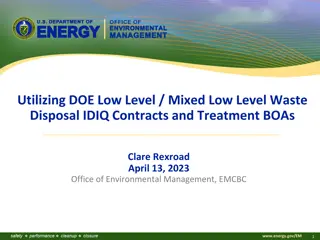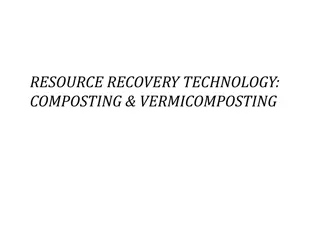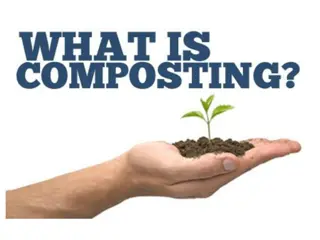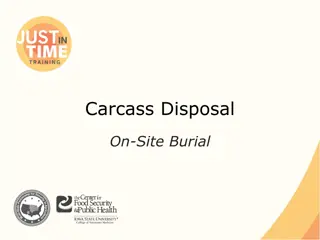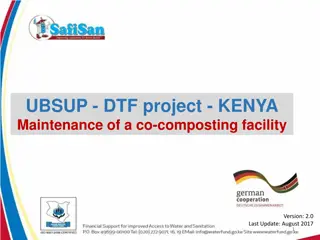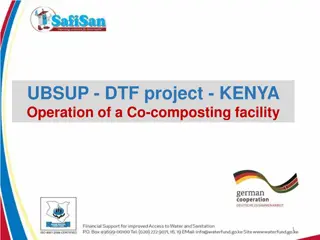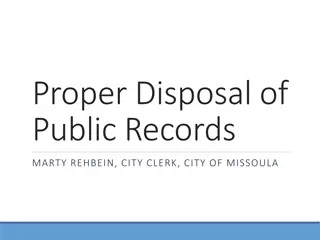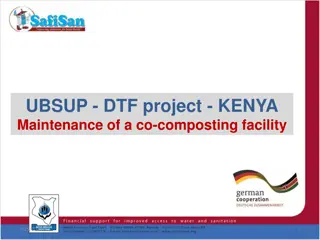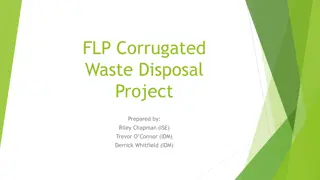Effective Carcass Disposal Through Composting
Composting carcasses with organic materials can accelerate biological decomposition, destroy pathogens, and produce a nutrient-rich humus. Proper carbon-to-nitrogen ratios, moisture levels, oxygen maintenance, and temperature control are crucial for the efficiency of the composting process. Mixing and monitoring the compost pile are essential to ensure optimal conditions for decomposition. This comprehensive guide provides detailed insights into the process of composting for effective carcass disposal.
Download Presentation

Please find below an Image/Link to download the presentation.
The content on the website is provided AS IS for your information and personal use only. It may not be sold, licensed, or shared on other websites without obtaining consent from the author.If you encounter any issues during the download, it is possible that the publisher has removed the file from their server.
You are allowed to download the files provided on this website for personal or commercial use, subject to the condition that they are used lawfully. All files are the property of their respective owners.
The content on the website is provided AS IS for your information and personal use only. It may not be sold, licensed, or shared on other websites without obtaining consent from the author.
E N D
Presentation Transcript
Carcass Disposal Composting
Composting Carcasses layered with organic material Thermophilic microbes Heat generation Accelerates biological decomposition Destroys pathogens Relatively safe and simple Nutrient rich, organic byproduct humus Carcass Disposal: Composting Just In Time Training
Compost Components Nitrogen Carcasses, manure Carbon Plant co-compost Sawdust, ground cornstalks, peanut hulls, mulch, poultry litter, leaves 3-5 yards3/1000# carcass Carbon: Nitrogen ratio 25:1 to 40:1 ideal Carcass Disposal: Composting Just In Time Training
Moisture Moisture 40-60% Crucial for microbial growth < 40% Slower degradation > 60% Fills air pockets, less oxygen/air flow Slower degradation Carcass Disposal: Composting Just In Time Training
Oxygen Maintains aerobic environment 5% ideal Dependent on pile porosity Encourage natural air flow Aeration Forced: use of fans Active: mechanical turning Passive: air exchange within pile Carcass Disposal: Composting Just In Time Training
Composting Process 1st phase aerobic Oxygen dependent High temperature (135-140oF) 3-12 weeks ~50% reduction in biodegradable solids 2nd phase curing Lower temperature (77-86oF) 10-240 days Aeration less critical Bulk density reduced 25% Carcass Disposal: Composting Just In Time Training
Temperature Temperature range 120-150oF Monitor frequently Inconsistent throughout pile cool zone on surface Ambient temperature can influence decomposition Carcass Disposal: Composting Just In Time Training
Mixing Accelerates decomposition When core temperature > 140oF <90oF Form new windrow or transport to second bin Carcass Disposal: Composting Just In Time Training
COMPOST DESIGN Carcass Disposal: Composting Just In Time Training
Location Indoors Less affected by Weather, ambient temperature, wind, scavengers Space limitations Vehicle movement Prolonged management and monitoring Outdoors Large animal Cover to protect Weather Scavengers Site location Away from public areas, animal areas, water sources Vegetated site Clay/impermeable base Carcass Disposal: Composting Just In Time Training
Basic Design Base layer (18-24 ) Porous Absorbent Carcasses Whole or ground Caution if zoonotic Carcass Disposal: Composting Just In Time Training
Basic Design Layer with co-compost (4-6 ) 5-7 feet high total 12 inches on sides Biofilter layer on top Weather dependent Cool weather-silage Warm weather-cornstalks Porous materials Absorbs moisture and promotes air flow Carcass Disposal: Composting Just In Time Training
Pile Types: Bins Construction Treated lumber or concrete 3 sided, doors, drop-board front Size dependent on carcass size and equipment used Secondary bins For mixing or storing co-compost Decreases scattered material Retains heat well Carcass Disposal: Composting Just In Time Training
Pile Types: Open and Windrows Size dependent on carcass Place carcasses away from pile edge Thick cover layer Management important Check temperature, monitor pile Add extra cover when necessary Carcass Disposal: Composting Just In Time Training
Distributing Compost FAD may make compost unsafe for cropland Soft tissue should be decomposed Large bones should be buried Nutrient levels should be tested Reuse as compost cover material Carcass Disposal: Composting Just In Time Training
CONSIDERATIONS Carcass Disposal: Composting Just In Time Training
Composting Considerations On-site process Adaptable process Nutrient rich end product Transport of co-compost material Regulations Carcass Disposal: Composting Just In Time Training
Record Keeping Start date of each compost batch Date and quantity of dead animal(s) or additions Internal temperature of each active compost batch Measured, at minimum, weekly Date compost material aerated Carcass Disposal: Composting Just In Time Training
Biosecurity Responders must Wear appropriate PPE Follow movement control procedures Vehicle cleaning and disinfection Site security Public perception Carcass Disposal: Composting Just In Time Training
Resources USDA Foreign Animal Disease Preparedness (FAD PReP) Guidelines: Disposal http://www.aphis.usda.gov/animal_health/emrs/nahems .shtml USDA Foreign Animal Disease Preparedness Standard Operating Procedures (SOP): Disposal http://www.aphis.usda.gov/emergency_response/tools/aphis_r ole_emergency_tools.shtml Carcass Disposal: Composting Just In Time Training
Acknowledgments Development of this presentation was by the Center for Food Security and Public Health at Iowa State University through funding from the Multi-State Partnership for Security in Agriculture Authors: Jessica Kennicker, BS Reviewer: Glenda Dvorak, DVM, MPH, DACVPM




